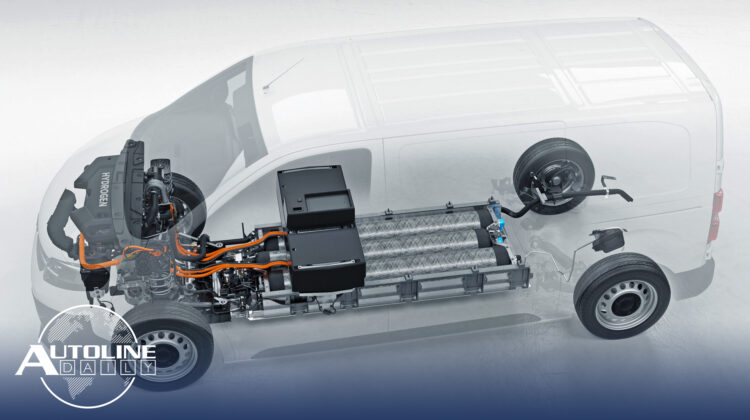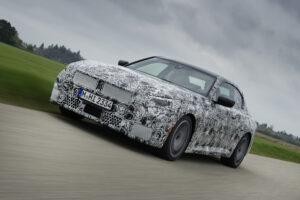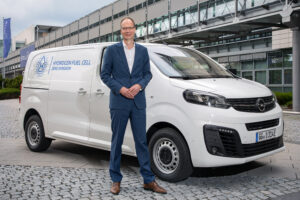
Listen to “AD #3081 – Opel Launches Hydrogen-Powered Van; Stellantis and Foxconn Form Partnership; BMW 2 Series Coupe Details” on Spreaker.
Follow us on social media:
Runtime: 10:12
0:08 Stellantis & Foxconn Form Partnership
0:50 Fisker Partners with Sharp on Electronics
1:23 Hong Guang Mini EV #1 EV In China
2:35 Are EVs Greener Than Gas Powered Cars?
4:02 BMW Shares Details About New 2 Series Coupe
5:30 Group Calls for Stricter Commercial Van CO2 Standards In EU
6:25 Opel Launches Hydrogen-Powered Van
8:04 Toyota 4Runner Impressions
Visit our sponsors to thank them for their support of Autoline Daily: Bridgestone, Intrepid Control Systems, Magna and Schaeffler.
This is Autoline Daily, the show dedicated to enthusiasts of the global automotive industry.
STELLANTIS & FOXCONN FORM PARTNERSHIP
Foxconn, the Taiwanese contract manufacturer, is getting heavily involved in the automotive industry. In January, it announced a venture with Geely to make EVs for Faraday Future. It also said it will make electric SUVs for Byton. Last week, it announced an agreement to make BEVs for Fisker. And today, it announced it will form a venture with Stellantis. Actually, last year, before the merger with Stellantis, Fiat-Chrysler announced it would form a joint venture with Foxconn to make electric and connected vehicles in China. Stellantis and Foxconn will announce the full details tomorrow morning.
FISKER PARTNERS WITH SHARP ON ELECTRONICS
But wait there’s more! Foxconn also owns Sharp, the giant electronics corporation. And Sharp is going to make all the in-car screens and components for Fisker. The companies say they’re going to offer the best-in-class screen resolution, with minimal power consumption. This is part of Fisker’s “asset light” strategy where it outsources almost all the development and manufacturing of its cars to avoid massive capital spending.
HONG GUANG MINI EV #1 EV IN CHINA
The tiny Wuling Hong Guang MINI EV was once again the top-selling electric vehicle in China last month. According to the China Passenger Car Association, more than 26,500 were sold in April. And through the first four months of the year, Wuling has sold nearly 100,000. Despite a range of only 105 miles, the EV has been a huge success since it launched last year, mostly thanks to its starting price of around $4,400.
ARE EVs GREENER THAN GAS POWERED CARS?
Are electric cars really greener than gasoline powered ones? David Welch from Bloomberg did an interesting comparison. He looked at electricity generated in West Virginia, 92% of which comes from coal. While a typical gasoline car emits 469 grams of greenhouse gasses per mile, a Jaguar I-Pace running on West Virginia electricity would account for 707 grams. But that’s the I-Pace. A Chevrolet Bolt would account for 451 grams and a Tesla Model Y would be at 430. But guess what? You can’t buy pure West Virginia electricity. It’s fed into a multi-state grid, which is not as coal intensive, so the real-world numbers would be better than this. David Welch then looked at the dirtiest grid in the upper Plains states. The I-Pace was somewhat better at 429 grams, the Bolt was substantially lower at 303 and the Model Y only accounted for 290 grams. This comparison does not include emissions from manufacturing or recycling, but it shows that even in the worst-case conditions, most EVs are cleaner than gasoline cars.
| All-Coal GHG Comparison | |
|---|---|
| Gasoline car | 469 g |
| Jaguar I-Pace | 707 g |
| Chevrolet Bolt | 451 g |
| Tesla Model Y | 430 g |
| Upper Plains Grid GHG Comparison | |
| Gasoline car | 469 g |
| Jaguar I-Pace | 429 g |
| Chevrolet Bolt | 303 g |
| Tesla Model Y | 290 g |
| Source: Bloomberg Hyperdrive Daily | |
BMW SHARES DETAILS ABOUT THE NEW 2 SERIES COUPE
BMW is trickling out details about the new 2 Series coupe, which goes into production later this summer. Today the focus is driving dynamics and here’s the highlights. Torsional stiffness is up about 12% thanks to additions like dynamic driving struts at the rear, while body roll is down due to an increased track width. Particular attention was paid to reducing the amount of lift on the front axle. This was done through a model-specific front spoiler lip, front splitter, front air curtains, air deflectors, a cover over the gas tank and rear axle and contours built into struts. The end result is a reduction of 50% compared to the previous model. Options that will improve the driving experience even more include an electronically controlled adaptive suspension system and variable sports steering that adjusts steering effort based on the driving situation. And lastly is powertrain, but BMW only revealed what’s going into the performance M version. Like the previous model, it’s available in all-wheel drive with an in-line 6-cylinder turbo, but horsepower is rated at 374, which is about 40 more than before. All that power is funneled through an 8-speed automatic.
STRICTER COMMERCIAL VAN CO2 REGULATIONS IN EU CALLED FOR
The European environmental group Transport and Environment is calling on the EU to enact stricter CO2 regulations for commercial vans. It says the standards are so weak most manufacturers can meet them without having to sell a zero-emission vehicle. Based on sales, it says 2020 CO2 levels from vans haven’t changed since 2017. Electrified passenger vehicles now account for 10% of overall sales in the EU but electric vans only account for 2% of the market. It wants the EU to push forward emission reduction targets and is calling for a 100% reduction by 2035, which would essentially ban ICE sales. It also wants to ban plug-in hybrids, arguing that owners don’t charge them properly and rely too much on the gas engine.
OPEL LAUNCHES HYDROGEN-POWERED VAN
Here’s a vehicle that could help. Opel is getting ready to launch a fuel cell version of its Vivaro van. You may remember a report from about a month ago that Stellantis is taking a unique approach with its hydrogen-powered vans. It’s using the same platform as its BEV vans, ripping out the batteries and replacing them with 3 hydrogen tanks. When combined with a 10.5 kWh battery pack that’s mounted under the front seats, Opel claims the van has a range of more than 400 kilometers or 248 miles based on the WLTP test. The Vivaro-e HYDROGEN will also be offered in two lengths and goes on sale this fall.
TOYOTA 4RUNNER IMPRESSIONS
We wonder if Toyota sings all the way to the bank when depositing checks for each 4Runner it sells? It’s an old body-on-frame design that’s powered by a ‘seems like it’s been around forever’ 4.0L V6 mated to a 5-speed automatic. Yet sales in the American market aren’t that bad. Toyota has sold nearly 50,000 units through the first four months of the year. One way it’s appealing to customers is by giving them a lot of options. Get this. There’s nine different trim levels available. And we were just in one of the newest packages, the Venture Edition, which was priced a little over $48,000. Think of this like a TRD Pro 4Runner but without the upgraded FOX suspension. It’s got the same 17-inch TRD wheels, TRD badging on the headrests as well as the ability to control off-road settings. It also comes standard with unique features like a Yakima roof rack and black accents on the badging, door handles, side mirrors and rear spoiler. We’re not a big fan of the 4Runner’s styling overall, but it looks better when you tack on all the off-road stuff, which is great because it seems like a decent number 4Runner buyers actually take their vehicle off road. We’ve got to believe that go-anywhere or at least perceived go-anywhere ability is one of the main selling points of this vehicle. Because the 4Runner just doesn’t feel or drive like a modern vehicle.
But that’s it for today, thanks for watching.
Thanks to our partner for embedding Autoline Daily on its website: WardsAuto.com
Seamus and Sean McElroy cover the latest news in the automotive industry for Autoline Daily.









